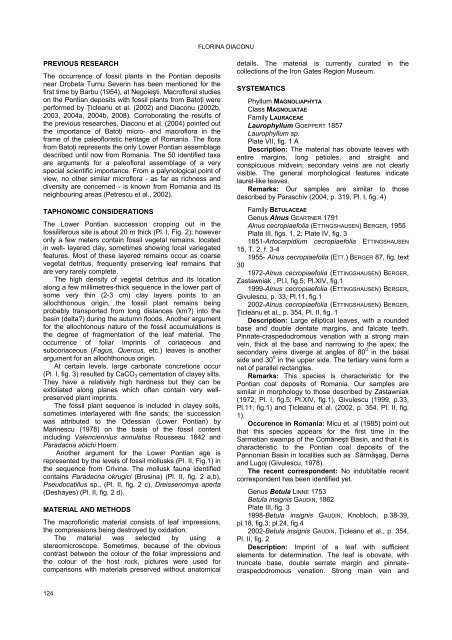Create successful ePaper yourself
Turn your PDF publications into a flip-book with our unique Google optimized e-Paper software.
FLORINA DIACONU<br />
PREVIOUS RESEARCH<br />
The occurrence of fossil plants in the Pontian deposits<br />
near Drobeta Turnu Severin has been mentioned for the<br />
first time by Barbu (1954), at Negoieşti. Macrofloral studies<br />
on the Pontian deposits with fossil plants from Batoţi were<br />
performed by Ţicleanu et al. (2002) and Diaconu (2002b,<br />
2003, 2004a, 2004b, 2008). Corroborating the results of<br />
the previous researches, Diaconu et al. (2004) pointed out<br />
the importance of Batoţi micro- and macroflora in the<br />
frame of the paleofloristic heritage of Romania. The flora<br />
from Batoţi represents the only Lower Pontian assemblage<br />
described until now from Romania. The 50 identified taxa<br />
are arguments for a paleofloral assemblage of a very<br />
special scientific importance. From a palynological point of<br />
view, no other similar microflora - as far as richness and<br />
diversity are concerned - is known from Romania and its<br />
neighbouring areas (Petrescu et al., 2002).<br />
TAPHONOMIC CONSIDERATIONS<br />
The Lower Pontian succession cropping out in the<br />
fossiliferous site is about 20 m thick (Pl. I, Fig. 2); however<br />
only a few meters contain fossil vegetal remains, located<br />
in well- layered clay, sometimes showing local variegated<br />
features. Most of these layered remains occur as coarse<br />
vegetal detritus, frequently preserving leaf remains that<br />
are very rarely complete.<br />
The high density of vegetal detritus and its location<br />
along a few millimetres-thick sequence in the lower part of<br />
some very thin (2-3 cm) clay layers points to an<br />
allochthonous origin, the fossil plant remains being<br />
probably transported from long distances (km?) into the<br />
basin (delta?) during the autumn floods. Another argument<br />
for the allochtonous nature of the fossil accumulations is<br />
the degree of fragmentation of the leaf material. The<br />
occurrence of foliar imprints of coriaceous and<br />
subcoriaceous (Fagus, Quercus, etc.) leaves is another<br />
argument for an allochthonous origin.<br />
At certain levels, large carbonate concretions occur<br />
(Pl. I, fig. 3) resulted by CaCO 3 cementation of clayey silts.<br />
They have a relatively high hardness but they can be<br />
exfoliated along planes which often contain very wellpreserved<br />
plant imprints.<br />
The fossil plant sequence is included in clayey soils,<br />
sometimes interlayered with fine sands; the succession<br />
was attributed to the Odessian (Lower Pontian) by<br />
Marinescu (1978) on the basis of the fossil content<br />
including Valenciennius annulatus Rousseau 1842 and<br />
Paradacna abichi Hoern.<br />
Another argument for the Lower Pontian age is<br />
represented by the levels of fossil mollusks (Pl. <strong>II</strong>, Fig.1) in<br />
the sequence from Crivina. The mollusk fauna identified<br />
contains Paradacna okrugici (Brusina) (Pl. <strong>II</strong>, fig. 2 a,b),<br />
Pseudocatillus sp., (Pl. <strong>II</strong>, fig. 2 c), Dreissenomya aperta<br />
(Deshayes) (Pl. <strong>II</strong>, fig. 2 d).<br />
MATERIAL AND METHODS<br />
The macrofloristic material consists of leaf impressions,<br />
the compressions being destroyed by oxidation.<br />
The material was selected by using a<br />
stereomicroscope. Sometimes, because of the obvious<br />
contrast between the colour of the foliar impressions and<br />
the colour of the host rock, pictures were used for<br />
comparisons with materials preserved without anatomical<br />
details. The material is currently curated in the<br />
collections of the Iron Gates Region Museum.<br />
SYSTEMATICS<br />
Phyllum MAGNOLIAPHYTA<br />
Class MAGNOLIATAE<br />
Family LAURACEAE<br />
Laurophyllum GOEPPERT 1857<br />
Laurophyllum sp.<br />
Plate V<strong>II</strong>, fig. 1 A<br />
Description: The material has obovate leaves with<br />
entire margins, long petioles, and straight and<br />
conspicuous midvein; secondary veins are not clearly<br />
visible. The general morphological features indicate<br />
laurel-like leaves.<br />
Remarks: Our samples are similar to those<br />
described by Paraschiv (2004, p. 319, Pl. I, fig. 4)<br />
Family BETULACEAE<br />
Genus Alnus GEARTNER 1791<br />
Alnus cecropiaefolia (ETTINGSHAUSEN) BERGER, 1955<br />
Plate <strong>II</strong>I, figs. 1, 2; Plate IV, fig. 3<br />
1851-Artocarpidium cecropiaefolia ETTINGSHAUSEN<br />
15, T. 2, f. 3-4<br />
1955- Alnus cecropiaefolia (ETT.) BERGER 87, fig. text<br />
30<br />
1972-Alnus cecropiaefolia (ETTINGSHAUSEN) BERGER,<br />
Zastawniak , Pl.I, fig.5; Pl.XIV, fig.1<br />
1999-Alnus cecropiaefolia (ETTINGSHAUSEN) BERGER,<br />
Givulescu, p. 33, Pl.11, fig.1<br />
2002-Alnus cecropiaefolia (ETTINGSHAUSEN) BERGER,<br />
Ţicleanu et al., p. 354, Pl. <strong>II</strong>, fig. 1<br />
Description: Large elliptical leaves, with a rounded<br />
base and double dentate margins, and falcate teeth.<br />
Pinnate-craspedodromous venation with a strong main<br />
vein, thick at the base and narrowing to the apex; the<br />
secondary veins diverge at angles of 80 0 in the basal<br />
side and 30 0 in the upper side. The tertiary veins form a<br />
net of parallel rectangles.<br />
Remarks: This species is characteristic for the<br />
Pontian coal deposits of Romania. Our samples are<br />
similar in morphology to those described by Zastawniak<br />
(1972, Pl. I, fig.5; Pl.XIV, fig.1), Givulescu (1999, p.33,<br />
Pl.11, fig.1) and Ţicleanu et al. (2002, p. 354, Pl. <strong>II</strong>, fig.<br />
1).<br />
Occurence in Romania: Micu et. al (1985) point out<br />
that this species appears for the first time in the<br />
Sarmatian swamps of the Comăneşti Basin, and that it is<br />
characteristic to the Pontian coal deposits of the<br />
Pannonian Basin in localities such as Sărmăşag, Derna<br />
and Lugoj (Givulescu, 1978).<br />
The recent correspondent: No indubitable recent<br />
correspondent has been identified yet.<br />
Genus Betula LINNE 1753<br />
Betula insignis GAUDIN, 1862<br />
Plate <strong>II</strong>I, fig. 3<br />
1998-Betula insignis GAUDIN, Knobloch, p.38-39,<br />
pl.18, fig.3; pl.24, fig.4<br />
2002-Betula insignis GAUDIN, Ţicleanu et al., p. 354,<br />
Pl. <strong>II</strong>, fig. 2<br />
Description: Imprint of a leaf with sufficient<br />
elements for determination. The leaf is obovate, with<br />
truncate base, double serrate margin and pinnatecraspedodromous<br />
venation. Strong main vein and<br />
124

















